What is the reason for the growing popularity of Internet and mobile payments in China?
The popularity of digital social networks in China can be explained by several factors:
- A large number of people move to urban centers in pursuit of employment, and this trend has led to the geographical separation of many families. The ability to easily communicate at a distance using audio, video calls and other communication tools is an effective and convenient solution. In this sense, China has much in common with other regions that are undergoing similar demographic changes and urban population growth.
') - Relatively cheap and full-featured smartphones are available everywhere in China. Thanks to the efforts of a number of local manufacturers, Chinese devices are much cheaper - at least $ 50 lower than their counterparts around the world. (However, in recent years, prices have increased due to the popularity of the iPhone, the average retail price of which is significantly higher). This factor has greatly accelerated the proliferation of smartphones: this figure in China is 20% higher than the world average. Mobile traffic is also cheaper here. For example, a 2-gigabyte package can be purchased from China Mobile for 120 yuan (17.4 dollars). A similar package from T-mobile in the US will cost 20.50 dollars. Chinese smartphones are perfectly compatible with the 4G telecommunications network, the coverage area of which allows serving 76% of the population. The latter figure is comparable to that of the United States (81%).
- Chinese millennials use mobile phones especially actively . For many of them, the smartphone is the first and often the only channel to access the Internet. Smartphones are cheap and simplify access to the network. In 2015, only 49.6% of Chinese families had a personal computer, while in the US, 87.3% of families had computers. Chinese users like to keep in touch with each other through online communication. This characteristic also unites China with other regions with a high level of penetration of mobile technologies and low prevalence of computers.
However, besides these supporting factors, there is also one significant obstacle that must be considered in the context of the spread of digital payments and financial services: a lack of trust.

Transition to digital technologies: cases of acquiring confidence and large-scale growth
The key factor underlying any operations involving money is trust. This includes confidence in the medium of exchange, security of the payment mechanism, the opposite side, and the regulatory environment as a whole. A thorough check at all these levels ensures the protection of consumers and the availability of the necessary regulation channels in cases where, in the opinion of one of the parties, an error or violation occurs.
As soon as the issue with trust is solved, another serious task arises - the achievement of the necessary scale. The experience of recent years shows that digital payments, if properly positioned in the market, can contribute to achieving scale and building trusting relationships with consumers.
Alipay: Growth and Trust
Alipay is one of the largest digital payment services in China. Alibaba Group launched its first e-commerce platform in 1998 in Hangzhou, China. The website was originally conceived as a B2B platform that allows overseas buyers to establish business relationships with Chinese sellers. In 2003, the company launched Taobao, a C2C platform that was a huge success.
Taobao is an e-commerce platform where ordinary people or small traders could create their storefront and sell products. At Taobao, the company did not sell any products, instead providing the merchant marketplace infrastructure, including technology, payment and logistics mechanisms.
Five years later, in 2008, Alibaba launched Taobao Mall (now known as Tmall), a B2C platform that achieved a similar level of growth and popularity. Like Alibaba, Tmall is also a platform for merchants, however, serving larger customers in terms of customer sales, providing them with more infrastructure services and support for the larger commission.
These two platforms quickly became China's largest e-commerce sites.
The transition of e-commerce from cash to digital technology
Most of the operations in the early days of Taobao and Tmall worked on a pay-as-you-go payment scheme, since cash at that time was the preferred and most trustworthy medium of exchange. The customer placed an order and paid it to the courier upon receipt. This scheme was not the most effective, but it worked as it should. At the same time, already in those years, there were online payment services, the services of most of which consumers used to pay bills and replenish their mobile balance. These services were not focused on e-commerce service. The consumer could conduct an online transaction, but could not go anywhere in the event of fraud. The funds were debited and transferred instantly, without any kind of challenging mechanism, such as those that are widely available today when making a transaction with credit cards or PayPal.
As a result, in 2004, Alibaba decided to create its own payment product. With Alipay, users can keep money in a digital wallet, replenishing it with any debit card linked to it, physical prepaid cards, or by direct money transfer as part of a P2P or B2C transaction.
After that, Alibaba has integrated Alipay with Taobao, which has already gained popularity with the platform. Taobao buyers got the opportunity to create an Alipay account and use its balance instead of cash during the ordering and payment process. The old cash payment method during delivery also continued to work. This allowed Alipay to instantly gain a large base of potential users, which helped the company to solve the problem of scaling the payment service. In order to gain trust from users and potential users, Alipay was designed as an interim storage system for funds: the merchant could not receive payment until the client confirmed that he was satisfied with the purchase.
Such an organization of the service and its linkage to the previously established e-commerce platform allowed Alibaba to solve the key problems of the payment industry - trust and scale - providing consumers with greater confidence in managing money relations with vendors thousands of kilometers away from them. The payment service quickly gained popularity and even when its market share somewhat decreased in 2015, even at that time 50% of all Internet payments in China were still made with it.
The first version of Alipay, launched in 2004, existed as a web application. The mobile application was launched in 2009. By 2016, Alipay processed 175 million transactions per day, 60% of which were sent from smartphones.
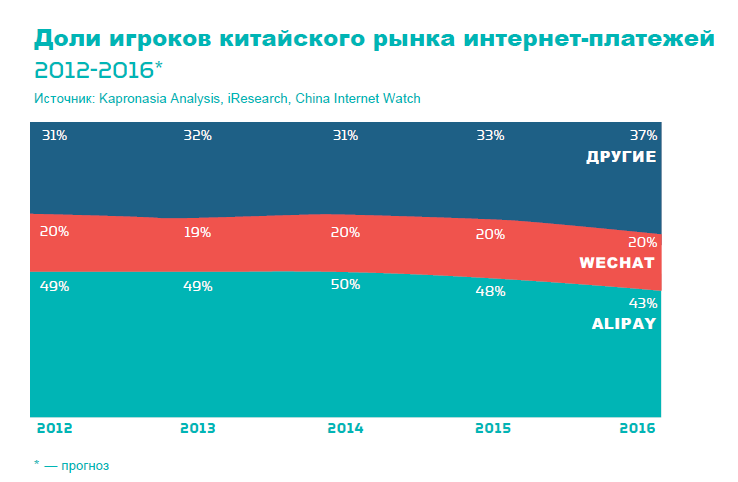
Tencent: another start, a similar result
Another popular payment service in the country was established by Tencent, founded in the Chinese city of Shenzhen in 1998. The company has two main social applications - QQ and Weixin, or WeChat in English. As of the 3rd quarter of 2016, the cumulative number of application users reached 846 million people.
QQ is an online chatting platform that offers both chat functionality and the ability to send email and remains popular despite the launch of WeChat. WeChat is in some way similar to Facebook and WhatsApp — popular social apps running in the United States several years before its appearance. WeChat allows two users to communicate with each other via messages, audio or video. In addition, the application simplifies communication between large groups of people and has built-in functionality called Moments, similar to the Timeline on Facebook. Moments allows subscribers to post images, thoughts, popular new articles and other materials that can be viewed by a limited number of people. Most users spend a significant amount of time in the app, opening it many times a day to check friends' news, publish posts, images, quotes and participate in their discussion.
Despite the fact that Tencent created one of the largest and most visited mobile social networks in the world, the introduction of payment functionality in WeChat made it really stand out from the general mass of analogues. In 2005, Tencent developed a digital payment application called Tenpay, launched nine months after Alipay. Tenpay allowed users to pay for Tencent products and services, such as online QQ-enabled games and music, and was also compatible with some other digital commerce platforms (with the exception of Taobao or Tmall - competitor brands Alibaba).
In 2013, Tencent integrated the Tenpay functionality into WeChat. This part of the application was called WeChat Pay and allowed users to open a digital wallet directly in the WeChat application and get access to a variety of payment solutions. Linking a debit or credit card to a wallet allowed you to transfer funds to other WeChat Pay users and store money for later use.
Less obvious at the time was the fact that digital payments allowed Tencent and Alibaba to enter the financial services market. Thus, the companies laid the foundation for the emergence of even greater business opportunities to offer additional products and services to create full-featured financial services systems.
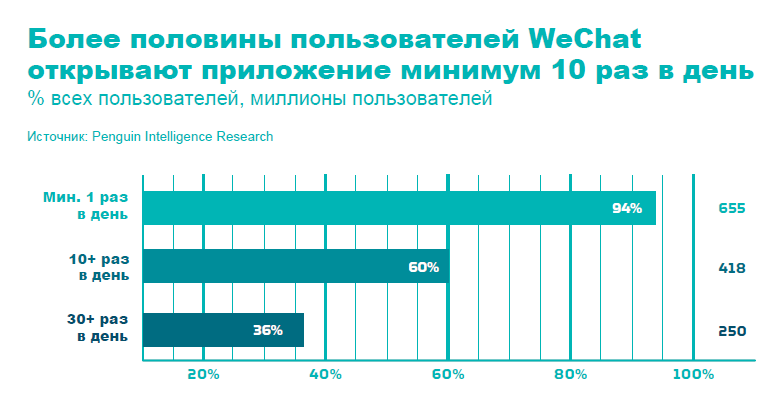
Growth and development of digital payment ecosystems
Apply existing e-commerce and social networking platforms as the basis for accelerating the development of digital financial services
The initial success of the Alibaba and Tencent payment products was a significant early step to accelerate the growth of China's digital financial services. However, even more significant advantages emerged when both companies used the power of existing e-commerce and social networking platforms. This combination has allowed millions of users to gain access to financial services and products previously inaccessible to them.
Social Finance
Tencent has also made significant strides in developing a wide range of products to improve its payment ecosystem and increase the demand for services. The company quickly realized that the simple integration of payment functionality with social networks is not enough to stimulate users' interest in services (in particular, Western social networks like Facebook are struggling to solve this problem). Tencent understood that in order for consumers to start using services and have developed a certain loyalty, they need effective motivation and a demonstration of the usefulness of the services offered.
How WeChat used social networks to encourage payments
WeChat has approached this challenge creatively. In 2014, Tencent introduced to the public a new campaign called “Red Envelopes”. It was a digital version of the old Chinese custom of donating a small amount of money to friends and family in red envelopes during the Chinese New Year.
The use of digital payments to send cash gifts was no longer a novelty at that time. However, WeChat gave this tradition a game form, allowing users to make a list of recipients and form a total amount to send. After that, the computer randomly distributed money among the people on the list.
This is how “Happy Envelopes” appeared. However, to get his reward, the lucky man needed to have a WeChat account tied to a bank account. Naturally, initially few recipients met this requirement, but the flow had an instant effect on the growth in the number of users. During the first week, 8 million people took advantage of the service, and the sharp increase in the number of new bank accounts connected to WeChat was measured in millions. Over the course of the week, WeChat users sent “happy envelopes” worth 400 million yuan (58 million dollars).
To further attract users, WeChat, like AliPay, subsidizes most of its payment functionality, making replenishment of the application wallet and payments made free with it. Initially, even the withdrawal of money from the application was free, but today both WeChat and Alipay charge a fee of 0.1% of the amount of funds withdrawn - an indicator that is significantly lower compared to fees for similar interbank transfers. All this encourages users to keep funds inside WeChat or AliPay payment systems.
The ability to easily and cheaply transfer funds to friends or other WeChat users who are connected to the payment functionality can be very useful. This is especially true for people who regularly receive remittances from family members separated by a large distance. The last moment can be even more widely used in other countries and markets.
Ecosystem creation
Gradually, Tencent continued to increase its attractiveness in the eyes of consumers, introducing new services built into WeChat. Over time, users were given the opportunity to purchase movie or plane tickets, book a hotel room, or get access to city services to pay utility bills or request a service. Now they can also call and pay for a taxi, order food delivery and pay off with a courier, purchase items online. Tencent has established relationships with vendors and merchants, and some of them have offered promotions using WeChat in physical stores.
Relatively recently, Tencent began to expand its presence in the international market. The company has entered into a partnership agreement with Western Union, allowing WeChat users to make low-cost money transfers using a mobile application in more than 200 countries. Now for many small firms it has become the norm to start a business right in WeChat, without having to spend time and money on traditional websites or a commercial backend. Tencent greatly simplifies both the creation of a direct sales channel and a sales network, as well as the opening of a virtual storefront, product promotion and payment acceptance from the first day of business.
API WeChat: many applications within one
Recently, WeChat also released a set of tools for developers - the so-called API, which allows start-ups to create applications for WeChat itself, expanding its capabilities. Today, mobile application developers have to create an iOS version of applications for the iPhone and an Android version for Android phones. Using the Tencent API saves them from having to think about operating system support, since using them places the application inside WeChat.
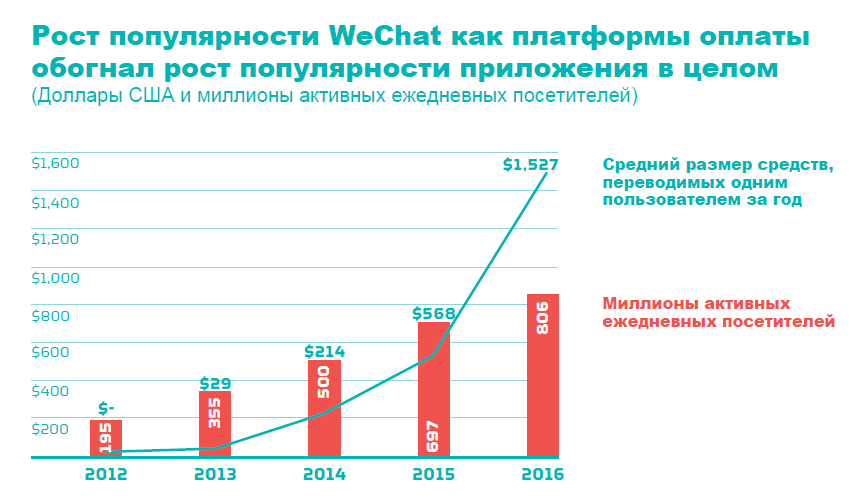
Alipay's first steps in social networks
In 2014, Alibaba’s Alipay service occupied 82.3% of the Chinese digital payments market, while WeChat Pay controlled only 10.6%. By 2016, however, this ratio has changed significantly: the share of Alipay fell to 68.4%, and WeChat Pay increased to 20.6%. The popularity of WeChat Pay’s growing payment ecosystem, which it is actively using to expand its social network, enabled it to quickly select part of the market from AliPay.
Realizing what attacks Tencent makes with the help of its chat and social network, Alipay made a number of changes in its own product, including the addition of some features similar to those available in WeChat.
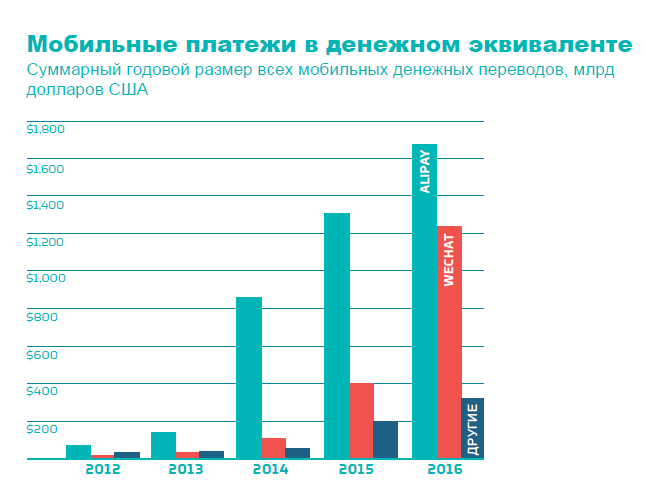

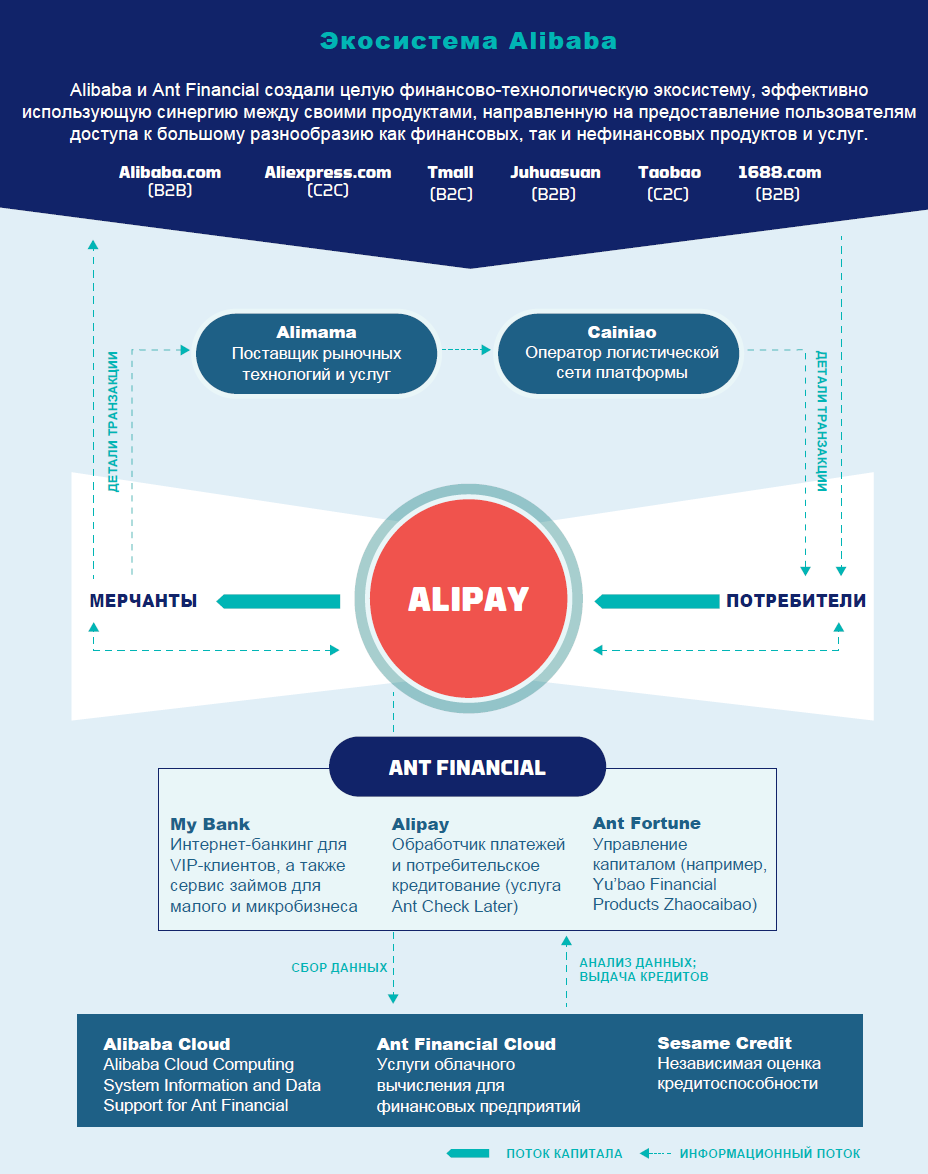
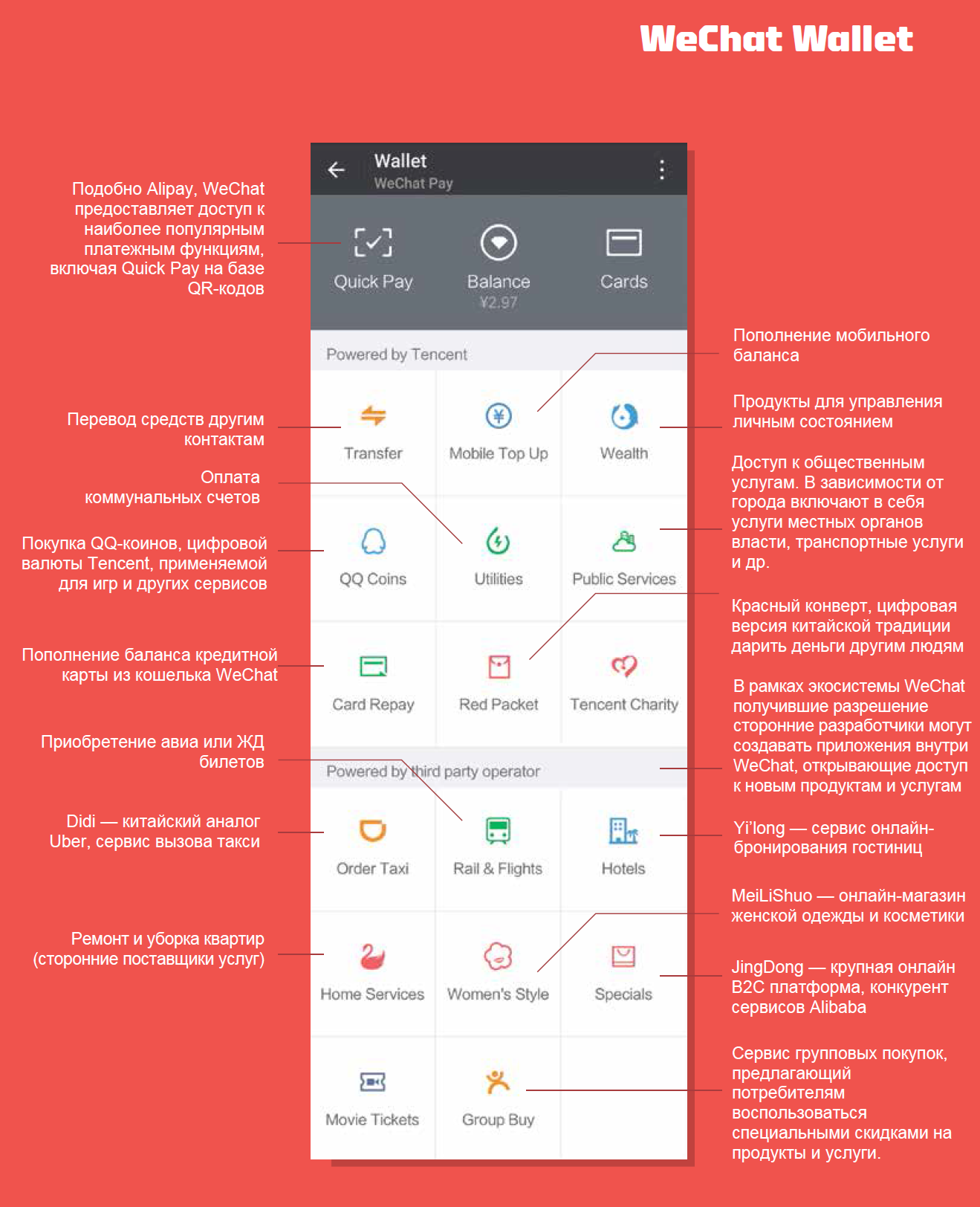
For example, Alipay added the ability to create online communities with enhanced social networking functionality, including Record my life - the analogue of WeChat Moments and Facebook Timeline. The company actually seeks to turn the wallet into a social network application with payment functionality.
Some applications in developed countries have also introduced functionality similar to innovations on the WeChat network. For example, WhatsApp introduced voice and video calls, and Facebook - the function of making payments. Time will tell whether international services will succeed in repeating the WeChat path to become a complex ecosystem, thereby stimulating its growth and retaining its relevance.
Comparison of key indicators of mobile applications
Instead of a conclusion, we present statistics illustrating the competition of the largest American and Chinese applications operating at the interface of communication and payments.
| Number of active visitors (million people / month, 2015) | The amount of processed mobile payments ($ billion, 2015) | |||||
|---|---|---|---|---|---|---|
| January 2011 | July 2012 | July 2012 | August 2013 | 697 | 396 | |
| Paypal | 1998 | Not | Not | 1998 | 179 | about 50 |
| Alipay | 2004 | Not | Not | 2004 | 450 | 1,316 |
| 2009 | April 2015 | November 2016 | Not | 1,000 | Not applicable | |
| Facebook messenger | August 2011 | April 2013 | April 2015 | March 2015 | 1,000 | Not applicable |

Source: https://habr.com/ru/post/373325/
All Articles